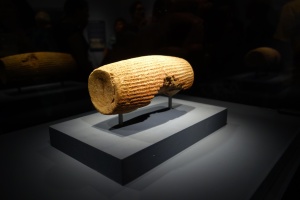
The Cyrus Cylinder is an ancient clay cylinder, now broken into several fragments, on which is written a declaration in Akkadian cuneiform script in the name of the Persia’s Achaemenid king Cyrus the Great.
The Cylinder has also been called the oldest known charter or symbol of universal human rights in the history of mankind. Neil MacGregor, Director of the British Museum, has stated that the cylinder was “the first attempt we know about running a society, a state with different nationalities and faiths — a new kind of statecraft.”

The Cylinder’s text has traditionally been seen by biblical scholars as corroborative evidence of Cyrus’ policy of the repatriation of the Jewish people following their Babylonian captivity (an act that the Book of Ezra attributes to Cyrus), as the text refers to the restoration of cult sanctuaries and repatriation of deported peoples.
It dates from the 6th century BC and was discovered in the ruins of Babylon in Mesopotamia (modern Iraq) in 1879. It is currently in the possession of the British Museum, which sponsored the expedition that discovered the cylinder. It was created and used as a foundation deposit following the Persian conquest of Babylon in 539 BC, when the Neo-Babylonian Empire was invaded by Cyrus and incorporated into his Persian Empire.
The text on the Cylinder praises Cyrus, sets out his genealogy and portrays him as a king from a line of kings. The Babylonian king Nabonidus, who was defeated and deposed by Cyrus, is denounced as an impious oppressor of the people of Babylonia and his low-born origins are implicitly contrasted to Cyrus’s kingly heritage. The victorious Cyrus is portrayed as having been chosen by the chief Babylonian god Marduk to restore peace and order to the Babylonians. The text states that Cyrus was welcomed by the people of Babylon as their new ruler and entered the city in peace. It appeals to Marduk to protect and help Cyrus and his son Cambyses. It extols Cyrus as a benefactor of the citizens of Babylonia who improved their lives, repatriated displaced people and restored temples and cult sanctuaries across Mesopotamia and elsewhere in the region. It concludes with a description of how Cyrus repaired the city wall of Babylon and found a similar inscription placed there by an earlier king.


